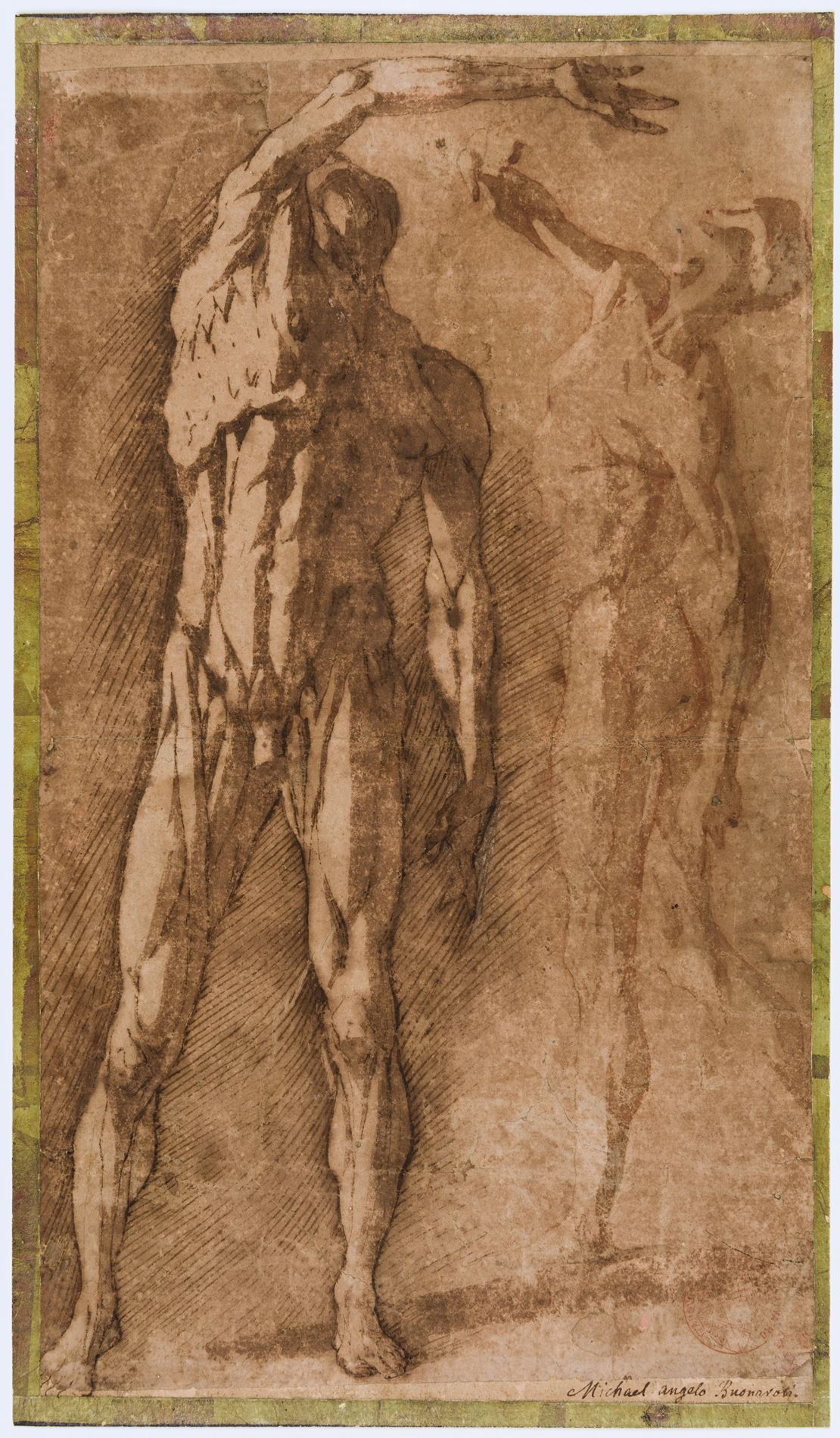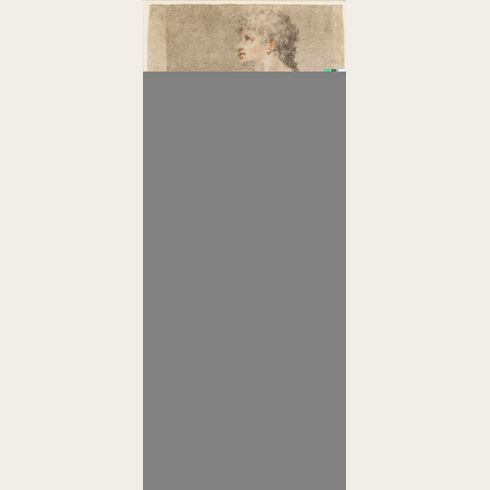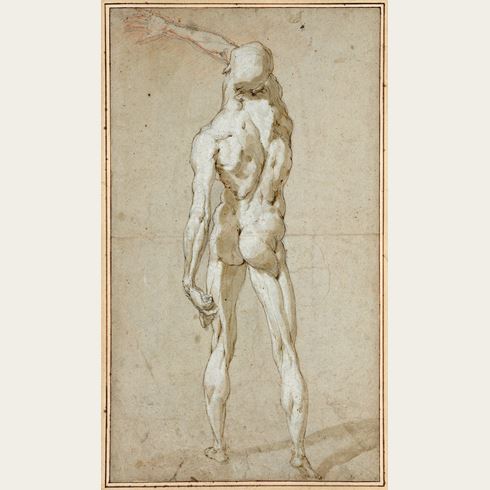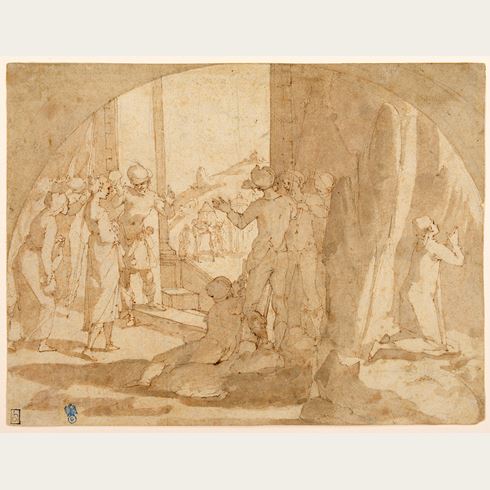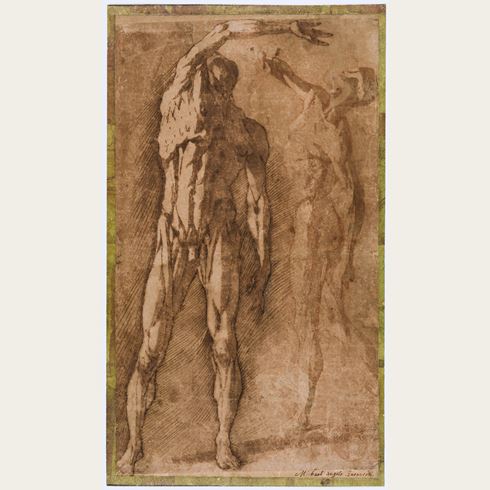Andrea BOSCOLI
(Florence 1560 - Florence 1608)
Two Studies of a Flayed Male Nude, after Pietro Francavilla
Inscribed Michael angelo Buonaroti. at the lower right.
Made up at the top and bottom edges and laid down on an old mount.
Inscribed No.2 and Bandinellii on the backing sheet.
A fragment of text from a French auction or exhibition catalogue (‘73. Deux hommes nues, debout.’) pasted onto the backing sheet.
406 x 236 mm. (16 x 9 1/4 in.) [sheet]
This study of a flayed male figure by Andrea Boscoli is a copy of a scorticato statuette by the Franco-Flemish sculptor Pietro Francavilla (1548-1615), a pupil and assistant of Giambologna in Florence. The only extant cast of this écorché sculpture is today in the Jagiellonian University Museum in Cracow in Poland, where it has been recorded since the late 18th century. (Standing approximately 42 cm. high, this is one of three ecorché bronzes by or attributed to Francavilla in the collection of the Jagiellonian University Museum.) Francavilla was known to have a particular interest in anatomy, and published a treatise on the subject, entitled Il Microcosmo, accompanied by his own illustrations. As Anthea Brook has noted of Francavilla’s bronze in Cracow, ‘in this statuette the mannerist delight in the intricacies of contrapposto is taken to unusual lengths. The static poses of earlier anatomical illustrations of the 15th and 16th centuries were developed by the time of Vesalius’s Treatise (1543) into a more mannerist style, in which the bend of the heads and the gestures of the hands are expressive and pathetic. It would indeed be difficult to find a more instructive example of mannerist sculpture than the present statuette.’ The Florentine biographer Filippo Baldinucci wrote of Francavilla that he produced a number of écorché statuettes in terracotta that were cast several times and were avidly studied by many artists.
Boscoli produced three other drawings after Francavilla’s scorticato statuette, from different angles. Two drawings in the Uffizi, both on blue paper, show the same figure from the right side and from the front, and strongly lit from the left. Monique Kornell has noted of the Uffizi drawings that ‘the evocative use of lighting, characteristic of the style of the Florentine draughtsman, matches the dramatic nature of the pose...The figure arches its back with its right arm flung across its body.’ Another drawing by Boscoli, showing the same figure from behind and drawn on blue paper, was with Stephen Ongpin Fine Art in 2015 and is today in an American private collection.
Boscoli’s own interest in anatomical drawings of this type finds close parallels in the similar studies of his contemporary in Florence, Ludovico Cardi, known as Cigoli (1559-1613). Around 1600 Cigoli produced a well-known wax model of a male écorché figure, known as Lo Scorticato (or La Notomia) and today in the Museo Bargello in Florence. Cigoli’s only known sculpture, the Scorticato was much celebrated in his lifetime and beyond and seems also to have been freely copied by Boscoli, in other drawings now in the Uffizi.
In his unpublished thesis on Boscoli’s drawings, Julian Brooks commented on the artist’s ‘characteristically strong chiaroscuro’ in his ecorché drawings, and adds that they ‘seem more concerned with the general effect created by the dramatic pose and taut musculature than the intricate detail per se.’ The Boscoli scholar Nadia Bastogi, who has noted ‘the heroic dynamism of these anatomical studies’, has dated these drawings to the final years of the 16th century. Although Anna Forlani Tempesti agreed with this dating, Brooks has suggested a slightly earlier date of c.1590-1595 for these ecorché studies, while Kornell has dated the Uffizi drawings to the late 1570s or early 1580s.
Andrea Boscoli trained in the Florentine studio of Santi di Tito and was admitted into the Accademia del Disegno in 1584. He visited Rome as a young man in the early 1580’s and, like many artists before him, avidly copied the frescoes of Polidoro da Caravaggio that decorated the facades of several palaces there. Between 1582 and 1600 Boscoli worked primarily in Florence, with brief stays in Siena and Pisa. His earliest known painting is the Martyrdom of Saint Bartholomew, painted in 1587 for the cloister of the Florentine church of San Pier Maggiore. He was also involved in the decorations for the apparati celebrating the marriage of the Grand Duke Ferdinando I de’ Medici to Christina of Lorraine in 1589.
In 1592 Boscoli completed a fresco cycle for the Villa di Corliano at San Giuliano Terme, near Pisa, and the following year painted an altarpiece of The Annunciation for the Chiesa del Carmine in Pisa. In 1597 Boscoli painted a Visitation for the Florentine church of Sant’ Ambrogio, followed two years later by a Crucifixion for SS. Apostoli, now lost, and an altarpiece of The Preaching of Saint John the Baptist in the church of San Giovanni Battista in Rimini, signed and dated 1599. Between 1600 and 1605 Boscoli worked mainly in the Marches, painting frescoes and altarpieces for patrons and churches in Fano, Fabriano, Macerata, Fermo and elsewhere, while the last years of his career were spent between Florence and Rome.
Relatively few paintings by Boscoli survive today, and it is as a draughtsman that he is best known. His drawings were highly praised by his biographer Filippo Baldinucci (who noted that ‘he drew so well...without lacking a boldness and an extraordinarily skillful touch’) and were avidly collected. Some six hundred drawings by Boscoli are known, with significant groups of drawings in the Uffizi in Florence (many of which were once part of the extensive collection formed by Cardinal Leopoldo de’ Medici), the Istituto Nazionale per la Grafica in Rome and the Louvre.
Provenance
His sale, Paris, Hôtel Drouot, 28-29 May 1891, lot 67 (as Michelangelo, ‘Deux Écorchés. Étude à la plume.’)
An unidentified collector’s mark in the form of a coat of arms indistinctly stamped in red at the lower right
Anonymous sale, New York, Christie’s, 23 January 2002, lot 23
Private collection.
Literature

